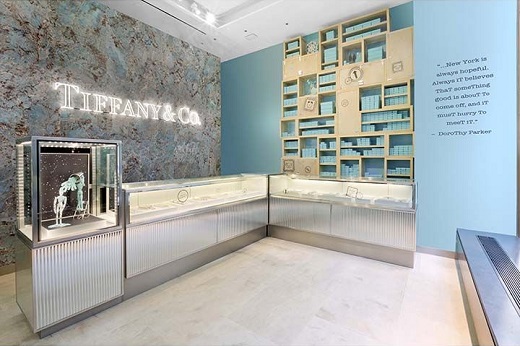Tiffany Sales Flat in 2019
 RAPAPORT... Tiffany & Co. reported solid sales in fiscal 2019 as it introduced new products and sold higher-value jewelry.Group revenue was flat at $4.4 billion for the year ending January 31, matching the record annual sales figure the company reported in 2018. Sales increased 2% to $1.3 billion in the Asia-Pacific region, while revenue in the Americas fell 2% to $1.9 billion. Sales in Japan rose 1% to $650 million, and proceeds in Europe slipped 1% to $498 million.The retailer introduced new products throughout the year, which buoyed sales, CEO Alessandro Bogliolo said Friday, with new designs for its men's collection proving popular with customers. The Tiffany T color collection was also well received. Worldwide comparable-store sales - at branches open for at least a year - fell 1%. Profit for the year fell 8% to $541.1 million.During the fourth fiscal quarter, global sales increased 3% to $1.4 billion, as the company sold a larger proportion of higher-priced jewelry."The largest growth [was] in our gold and gold-and-diamonds offerings," Bogliolo noted. "The higher price points of these items contributed to the approximately 10% increase in our overall average unit retail price this full year compared to the prior one."Profit for the three-month period slipped 2% to $201 million as a result of costs associated with the company's proposed acquisition by LVMH, it said.The company's fourth-quarter results were better than expected, according to analyst group Cowen. However, Cowen expects sales to weaken in the first quarter, with the decline predicted to be about 16% year on year.Tiffany did not provide its outlook for the 2020 fiscal year due to the pending completion of the merger, it said. LVMH is considering buying Tiffany shares for less on the open market, meaning it would not have to pay tariffs and other fees, according to a Bloomberg report. Meanwhile, Tiffany noted it would concentrate on returning to normal operations amid the coronavirus outbreak. "We have had to temporarily close or shorten operating hours of certain stores around the globe," Bogliolo added. "For example, in the Chinese mainland, since January 24, 2020, we have lost approximately half of our total normal retail trading days as a result of closures or shortened hours of operations."Image: A Tiffany store in Rockefeller Center, New York. (Tiffany & Co.)
RAPAPORT... Tiffany & Co. reported solid sales in fiscal 2019 as it introduced new products and sold higher-value jewelry.Group revenue was flat at $4.4 billion for the year ending January 31, matching the record annual sales figure the company reported in 2018. Sales increased 2% to $1.3 billion in the Asia-Pacific region, while revenue in the Americas fell 2% to $1.9 billion. Sales in Japan rose 1% to $650 million, and proceeds in Europe slipped 1% to $498 million.The retailer introduced new products throughout the year, which buoyed sales, CEO Alessandro Bogliolo said Friday, with new designs for its men's collection proving popular with customers. The Tiffany T color collection was also well received. Worldwide comparable-store sales - at branches open for at least a year - fell 1%. Profit for the year fell 8% to $541.1 million.During the fourth fiscal quarter, global sales increased 3% to $1.4 billion, as the company sold a larger proportion of higher-priced jewelry."The largest growth [was] in our gold and gold-and-diamonds offerings," Bogliolo noted. "The higher price points of these items contributed to the approximately 10% increase in our overall average unit retail price this full year compared to the prior one."Profit for the three-month period slipped 2% to $201 million as a result of costs associated with the company's proposed acquisition by LVMH, it said.The company's fourth-quarter results were better than expected, according to analyst group Cowen. However, Cowen expects sales to weaken in the first quarter, with the decline predicted to be about 16% year on year.Tiffany did not provide its outlook for the 2020 fiscal year due to the pending completion of the merger, it said. LVMH is considering buying Tiffany shares for less on the open market, meaning it would not have to pay tariffs and other fees, according to a Bloomberg report. Meanwhile, Tiffany noted it would concentrate on returning to normal operations amid the coronavirus outbreak. "We have had to temporarily close or shorten operating hours of certain stores around the globe," Bogliolo added. "For example, in the Chinese mainland, since January 24, 2020, we have lost approximately half of our total normal retail trading days as a result of closures or shortened hours of operations."Image: A Tiffany store in Rockefeller Center, New York. (Tiffany & Co.)